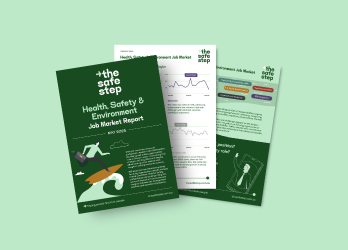Resume Writing for Safety Professionals
Page Published Date:
August 5, 2025
It’s a tough truth, especially given how much time and effort goes into crafting a resume—but your resume has around six seconds to capture a hiring manager's attention before they move on. In that moment, your years of expertise in workplace safety, system development and team leadership either spark interest—or get lost in the pile.
Many accomplished safety professionals undersell themselves on paper—not because they lack capability, but because their resume doesn’t clearly communicate their true value. Read on to learn how to translate your real impact into a clear, compelling resume that helps you stand out.

Format for Success
Before diving into content strategy, let's tackle the technical barriers that could derail your application before human eyes see it. Modern recruitment relies heavily on Applicant Tracking Systems (ATS). As specialist HSE recruiter Chris McNicol explains: "Tables and fancy formatting can confuse recruitment systems, so candidates need to choose clarity over creativity."
Your resume formatting checklist:
- Professional fonts (Arial, Calibri, Times New Roman at 10-12pt for body text)
- Clean section headings with consistent spacing
- Left-aligned text with 1-inch margins
- PDF format to preserve your layout across different devices
- Professional email address dedicated to your job search
The Achievement Formula That Opens Doors
This is where most safety professionals miss the mark. They list responsibilities instead of demonstrating impact. Our recruitment team consistently guides candidates toward this proven approach:
"Accomplished [X] as measured by [Y], by doing [Z]."
Instead of: "Responsible for safety culture on site" Write: "Transformed safety culture across three business divisions, achieving 65% reduction in lost-time injuries as measured by 18-month trending analysis, by implementing behaviour-based safety programs and establishing cross-functional leadership teams."
Notice the difference? The second example immediately communicates scale, measurable outcomes and strategic thinking—exactly what senior hiring managers want to see.
This formula for success - the rule of three – isn’t just for resume writing. It’s invaluable across your job search, from structuring interview responses to refining your professional profile.
Your Professional Summary
Your opening summary isn't just an introduction—it's your elevator pitch. This 3-4 line section should immediately establish your seniority and value proposition.
Strong example: "Strategic safety leader with 12+ years driving organisational culture transformation across mining and construction sectors. Delivered 40% reduction in recordable incidents while implementing enterprise-wide safety management systems for 3,000+ workforce. Proven ability to influence C-suite stakeholders and negotiate complex regulatory requirements at senior industry levels."
This summary works because it establishes experience level, quantifies business impact and signals the ability to operate at executive level—all within seconds of scanning.
Tailoring for Safety Resume for Executive Impact
As you move into more senior safety roles, your resume needs to do more than outline responsibilities - it should reflect strategic thinking, influence and commercial awareness. “The best resumes show me that the person cares, communicates with clarity and understands the bigger picture,” says McNicol. “Straight away, you get a sense of their ability to operate at a senior level and connect safety to business outcomes.”
Demonstrate leadership at scale by showcasing team sizes, organisational scope and stakeholder influence. Connect safety initiatives to business performance with hard numbers around risk reduction, cost avoidance and productivity improvements. Position yourself as someone who understands commercial realities while driving safety excellence.
For traditional safety leadership roles, emphasise regulatory compliance, system implementation and culture development. If you're targeting emerging hybrid HSE-wellbeing positions, highlight cross-functional collaboration, data-driven health initiatives and integration of mental health programs.
The Customisation Imperative
"Each resume should be highly customised," advises McNicol. "The ones that don't land well read like they're for transport rather than this industry—confusing and unfocused."
This means starting fresh for each application. Analyse the job description for key requirements, align your experience with their specific needs and mirror their language while maintaining authenticity. Research the company to understand their safety challenges and tailor your achievements accordingly.
Avoiding Career-Limiting Mistakes
Even experienced safety professionals make resume errors that cost opportunities. Common pitfalls include verbose presentation that suggests poor communication skills, simply copying job descriptions without demonstrating personal innovation and focusing solely on compliance while ignoring business leadership capabilities.
Keep your content focused—most safety professionals should aim for 2-3 pages, with comprehensive senior careers potentially extending to 4 pages. Prioritise recent and relevant roles, summarise earlier positions briefly and ensure every bullet point adds unique value to your candidacy.
Ready to Accelerate Your Career
Your resume is your first chance to demonstrate the strategic thinking and attention to detail that define exceptional safety professionals. When crafted well, it can open doors to meaningful career progression.
While your resume is the first step, it's only one part of your broader career toolkit. Get it right and it becomes the foundation for positioning yourself effectively—across job applications, recruiter conversations and professional platforms.
Building a quality relationship with a specialist safety recruiter, like those at The Safe Step, can provide expert feedback and guidance to help sharpen your resume and navigate your next move with confidence.
Your next opportunity is out there—make sure your resume is ready to secure it.




